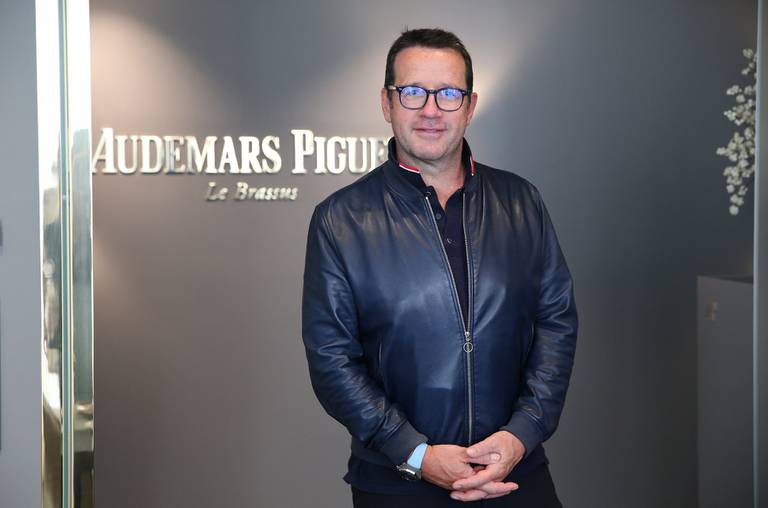
Demand at the top end of the watch market is booming — and Audemars Piguet, the Swiss watchmaker whose cult Royal Oak timepieces will set shoppers back between $50,000 and $100,000 for most popular styles, is making a killing.
Over the past five years, Audemars Piguet’s sales more than doubled, surpassing 2 billion Swiss francs ($2.2 billion) last year, the family-owned watchmaker told BoF.
While it’s still smaller than industry leader Rolex, Audemars Piguet has overtaken Patek Philippe to become the world’s second-largest independent watch brand, and successfully cemented itself as one of the industry’s most coveted labels, favoured by rappers, rockstars and horologists alike. As sales of luxury timepieces rose 4 percent to $55 billion last year, Boston Consulting Group estimates, Audemars Piguet grew by at least 25 percent, according to BoF analysis.
Even as second-hand prices for many watches have cooled from record highs during the pandemic, buyers continue to pay high premiums on retail prices for Audemars Piguet’s Royal Oak, which can be difficult to track down on the primary market due to limited quantities and surging demand.
“Audemars Piguet is probably the singular most in-demand brand in the world from a product perspective. It might even be more desirable than Rolex right now,” said Ben Clymer, founder of Hodinkee, the influential watch media and retailer.
Audemars Piguet — or “AP” as its colloquially known among followers — isn’t simply riding the wave of post-pandemic demand. While the value of the market is at a record high, the volume of new watches being exported from Switzerland has roughly halved since 2000 amid the rise of smart watches. The company is pulling ahead in a sector that has become more polarised and premiumised, with growth driven by just a handful of top-end brands.
Many credit the work of outgoing CEO François-Henry Bennahmias, the brand’s chief executive since 2012, for transforming the brand’s fortunes and catapulting it to the “champions league” of the watch world, as Swiss watch analyst Oliver Müller puts it. Bennahmias is set to step down at the end of this year to pursue other opportunities.
When Bennahmias took the top job, Audemars Piguet watches were languishing in stores, with about 30 percent of the brand’s global inventory more than three years old, he told BoF.
Clymer remembers when Royal Oaks traded at considerable discounts. “I have distinct memories of being offered Royal Oaks at 40 percent off — 50 percent off at times — at retail. They were just looking to move inventory,” he said. “It’s hard to imagine now.”

Bennahmias, who began his career as a pro golfer before leaving sports behind for the luxury industry, overhauled the Swiss watchmaker’s business model and brand. He eschewed its longstanding wholesale model in favour of direct-to-consumer distribution and fostering close relationships with clients, while an early embrace of street culture and collaborations helped the brand get a head start on rivals as the audience for luxury timepieces became younger and more diverse. By bolstering Audemars Piguet’s offer of ultra-high-end models and limited editions, Bennahmias burnished the brand’s image, excited the market and boosted revenues to boot.
“The vision was to focus on making everything better, instead of more: so better product, better quality, better distribution, better connection with people,” Bennahmias said.
The focus on selling directly to the consumer has helped Audemars Piguet grow its revenues rapidly without drastically ramping up production, as the brand captures hefty retailer markups on each sale and has a tighter grip on its inventory management. Production at Audemars Piguet remains well below competitors: in 2021, it sold 45,000 watches, compared with 68,000 at Patek Philippe, 600,000 at Cartier, and over 1 million at Rolex, according to Morgan Stanley estimates.
The DTC model remains a rarity in the high-end watch world: In 2021, Rolex, Patek Philippe and Swatch-owned Omega all relied on wholesale for over 70 percent of sales, Morgan Stanely estimates show, while Audemars Piguet drove over 70 percent of revenue from its own stores. Only Richard Mille, which sells just 5,000 watches a year exclusively in its own stores, has a tighter control of its distribution among the industry’s big players.
Drastically shrinking Audemars Piguet’s wholesale exposure also meant Bennahmias’ could focus on maintaining fewer, but better, retail locations. Now the brand has just 99 points of sale globally, compared with with 470 a decade ago.
Bennahmias’ approach to retail has been to focus investments on well-trained staff and high-touch services, rather than vying with luxury conglomerates like LVMH for high-visibility retail spaces. In 2019, the brand debuted its “AP House” concept: private boutique spaces that look and feel more like five-star apartments than retail stores. The inaugural location, above a Church’s store on London’s Bond Street, has no store frontage at street level. Its main room is outfitted with a bar, a grand piano, and even a pool table, inviting clients to have a relaxed, intimate experience.
“At our price point, the exposure and space we need to host people the right way,” Bennahmias said. “We’re only selling 50,000 watches. I want to get to know the 50,000 people who are buying every year.”
The set-up has worked wonders, with clients spending three to four times as much as they would in a traditional store. In four years, the brand has opened 15 AP Houses, including in New York, Shanghai, Tokyo and Zurich. “In our future, maybe 50 percent of our locations will be houses, and 50 percent will be [traditional] retail,” Bennahmias mused.
Audemars Piguet is set to launch a pre-owned watch programme in-house within the next year. While second-hand watches are a complex business for brands — and not easy to make profitable — the move will add an additional layer of control over its brand image and relationships with consumers.
Bennahmias’ own passion for sports and music has heavily influenced Audemars Piguet’s move to embrace and cultivate its role in popular culture in a way that few other watch brands have done. In 2005, when Bennahmias was AP’s North America chief, he spearheaded a tie-up with Jay Z, releasing a limited-edition Offshore watch with the rapper at a time when collaborations with hip-hop stars were unheard of in the luxury industry. Since then, the brand has regularly rolled out limited-edition product collaborations with athletes and artists ranging from Lionel Messi and Sachin Tendulkar, to LeBron James and Quincy Jones.
AP’s more inclusive approach to building relevance in sports, music and street culture paid dividends as millennials came of age and the worlds of luxury fashion and streetwear collided: the brand has come out ahead of rivals when it comes to attracting a younger and more diverse customer base.
The brand’s collaborations proved a winning strategy, serving to animate their flagship product in new ways while engaging a variety of different communities. Even more off-beat tie-ups continue to drive hype as appetite for unique pieces soars among luxury consumers. Take last year’s collaboration with Marvel on a Royal Oak Concept inspired by the Black Panther movie: a one-off special edition fetched $5.2 million at a charity auction during the collaboration launch event.
“Francois saw the potential in what popular culture could mean to high-end watchmaking really, really early — and he embraced it in a way that nobody did back then, and very few even do today,” Clymer said.
A successor has yet to be named to follow up Bennahmias’ transformative tenure when the executive exits later this year.
“The challenge for [the next CEO] is quite high,” said Oliver Müller, industry analyst and founder of consulting firm LuxeConsult. “His or her mission will be to stabilize growth, and get into a mode where they will still grow but probably in a less spectacular way.”
Analysts say there’s plenty of room for the brand to keep growing without diluting its appeal. While the flagship Royal Oak drives over 90 percent of revenues for the brand according to LuxeConsult estimates, demand for the watch isn’t set to die down anytime soon, as production remains limited and new buyers compete with AP die-hards, who sometimes collect multiple editions of the classic model.
But Bennahmias’s impending exit and recent changes to the company’s board have set off speculation about a potential sale of the brand. Italian luxury executive Alessandro Bogliolo was named chairman of the board last November after Jasmine Audemars, great-granddaughter of the brand’s co-founder Jules-Louis Audemars, retired. As pointed out by respected industry blog Miss Tweed, Bogliolo’s specialty is not luxury watchmaking, and he has a reputation for selling luxury businesses at a high price: Bogliolo was behind the blockbuster sale of Tiffany & Co. to LVMH in 2020.
LVMH would be a credible suitor: AP’s estimated 15 billion swiss franc valuation ($16.1 billion) would make an acquisition one of luxury’s biggest ever deals — and price out most other prospective purchasers.
However, as the brand flourishes as an independent company, there’s little pressure to force family shareholders to cash out. “Thanks to Mr Bennahmias and his teams, the networth of the brand is about 10 times what it was when he came in,” said Müller. “If I’m a shareholder at Audemars Piguet, why would I sell if the brand pays me a very good dividend every year?”
The company said in a statement it was drawn to Bogliolo’s “sound understanding of family-run businesses” and his experience developing luxury brands at an international level.
Bennahmias denied there were any intentions to sell the company after his departure.
“We are extremely firm on the message that we’ve been delivering for ever, saying that we are very proud of our independence, and we’ll keep working that way,” he said.



